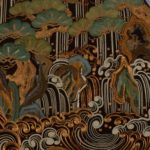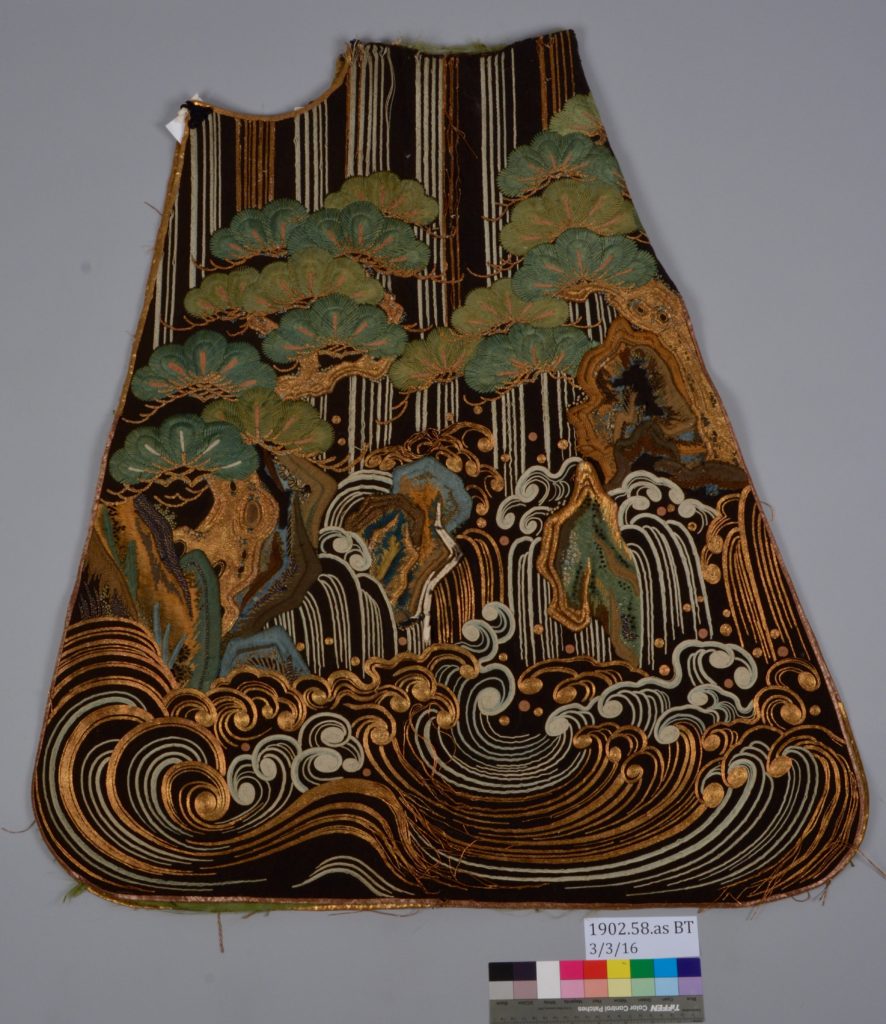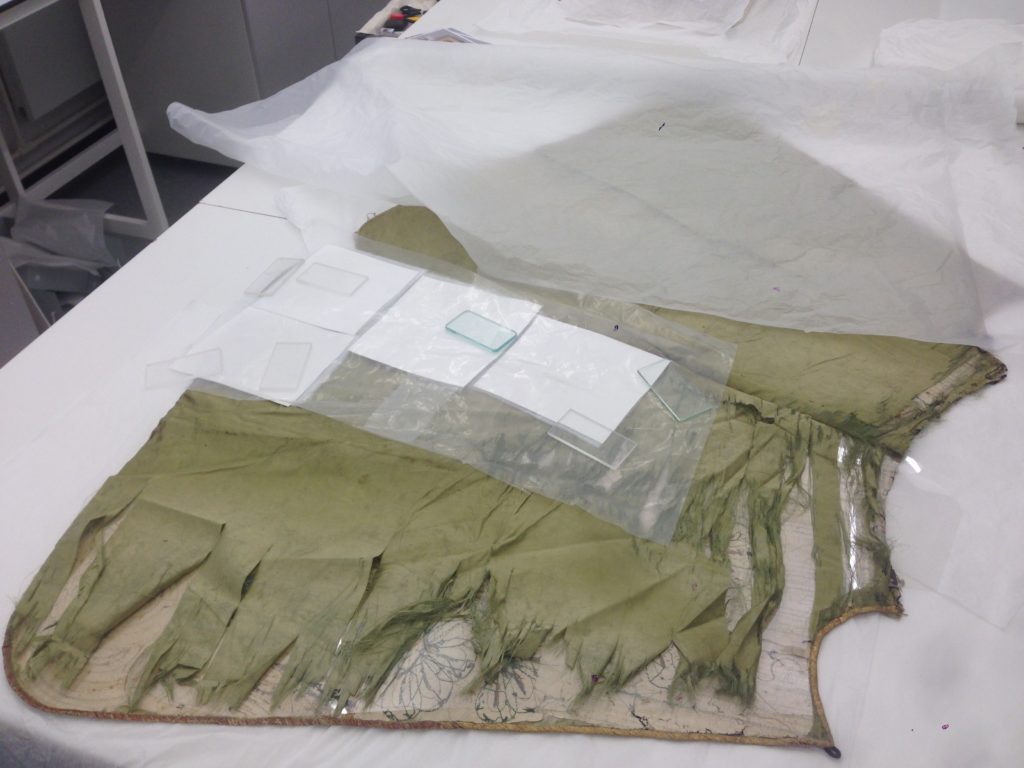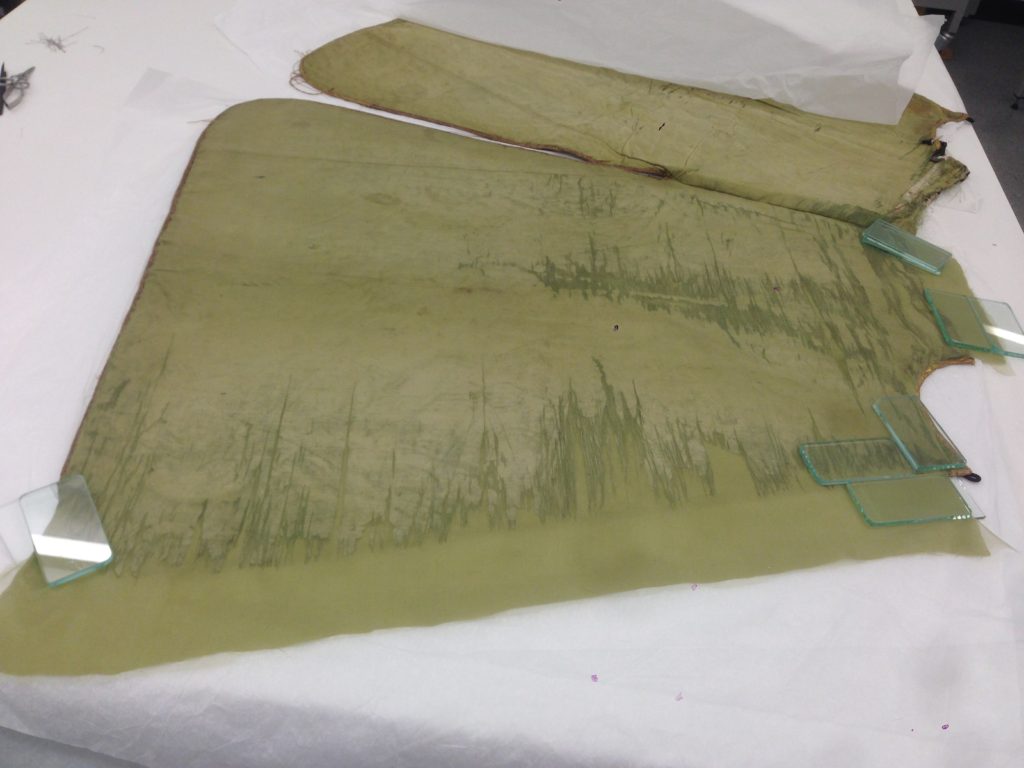
By Nora Frankel, second year student, MPhil Textile Conservation.
For me, getting a new object for treatment in our second semester ‘Principles and Practice’ class is always met with excitement and anticipation. When I lifted the tissue paper off what was to be my final project after reading the short description and client brief, I wondered if there had been a labelling mix-up. The description read “Japanese fire fighting helmet cover,” but the object, which took up one and a half studio tables and was lushly covered in gold and silk embroidery, didn’t seem to match the description.

The object, which had not been subject to a mix-up, is owned by Glasgow Museums, and came to the Centre for treatment of several structural and aesthetic issues that had prevented it from being displayed. The cover is beautiful and unique, with a bold waterfall landscape embroidered in different techniques of couched silk thread and gilt paper. Like English stumpwork, parts of the embroidery are raised. Instead of the European use of threads and fabric, the three dimensional substrate in this case is built up with coiled paper, which is then couched down with silk threads and embroidered over in gilt paper and silk.
The cover, which resembles a cape, is known as a hikeshi-shikoro, and would have been attached to a helmet at the top and wrapped around the face and upper body to protect the wearer from flames and smoke. It dates from the Edo Period (1603-1868), which marks a fascinating transition period in Japan’s history from the more traditional Feudal system with a strong presence of warrior samurai to a more urban culture that, by the 19th century, saw an increase in the merchant middle class (chonin), who had previously been at the bottom of the Japanese social hierarchy.
As in Europe, this early modern period saw a dramatic and devastating increase in fires. These flames swept through Edo (Tokyo) both by accident and arson, and were prominent enough to be named one of the “Flowers of Edo.” They also warranted the creation of several fire brigades.
In a reflection of the social order of the day, Samurai, the hereditary elite, had their own bridage, the hikeshi-daimyo, who protected the aristocratic and castle areas of the city, while the chonin were in charge of their own section of Edo. These machi-hikeshi eventually rose to social fame, and were often the subject of Kabuki as well as being generally regarded as heroes, a concept alone that threw the class hierarchy on its head by the end of the Edo period.
Determining which type of hikeshi this cover belonged to relied on several clues. The black background fabric is made of wool, an uncommon material in Japan at this time. During the Edo period, several sumptuary laws were in place, restricting the use of heavy ornamentation and wool to the upper classes. In fact, European wool fabric was used almost exclusively for Samurai coats and fire fighting apparel. Stylistically, the cover resembles the shikoro, or neck protector of the Samurai armour. In fact, this object carries that name.
Furthermore, the machi-hikeshi typically wore cotton garments for firefighting, which they would douse in water before entering the burning building. As access to large amounts of running water was less common outside the aristocratic castle areas of the city, machi-hikeshi often used dry firefighting techniques such as guiding and dousing flames. This accounts for their different style of dress as well.
The high level of ornamentation coupled with the lack of smoke damage suggests it was not worn on active duty. As fires were such a concern in Edo Japan, the Samurai would ensure that their family was protected by providing a hikeshi-shikoro to each member, meaning that this could have been worn by someone who was not actually a firefighter themelves. The Boston Museum of Fine Arts has some nice examples of these (http://www.mfa.org/collections/object/neck-protector-for-firemans-helmet-hikeshi-shikoro-68378), although not as elaborate as Glasgow Museums’, and at least one was likely owned by the wife of the daimyo rather than a firefighter.
My treatment, which is part of a two-year project that will be continued by a student in 2017, included cleaning, humidification, and stabilisation of the lining, as well as securing the loose embroidery on the face. Hopefully after completion, this stunning piece can finally go on display to share the complex and surprisingly parallel history of modernisation in the east, with the west.





